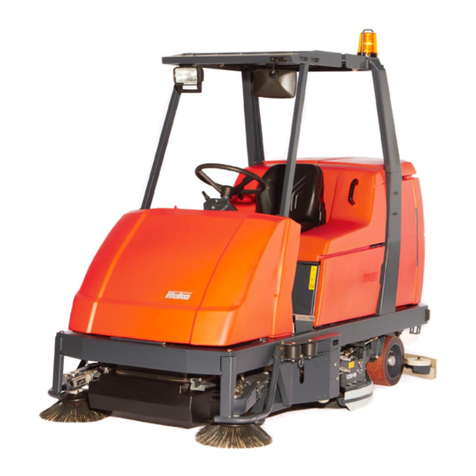
7
Safety information
1.2 General notes
• Apart from the instructions in this op-
erating manual, the general safety
and accident prevention regulations
of the legislation must be taken into
account.
• Before the machine is put into ser-
vice, please read carefully the oper-
ating manual you receive as well as
further separate instructions for (ad-
ditional) attachments and observe
them in all aspects in your work.
• The machine may be used, main-
tained and repaired only by persons
who have been instructed by Hako
experts.
• This device may not be used by per-
sons (including children) with re-
duced physical or mental abilities or
by persons without sufficient experi-
ence and skills.
• You should pay special attention to
the safety instructions. For errors in
operating the machine can be avoid-
ed and trouble-free operation can be
guaranteed only with precise factual
knowledge.
• The operating manual must be avail-
able constantly at the place of use of
the machine and should therefore be
kept carefully on the device.
• Please hand over these documents
to the new owner/operator on sale or
rental of the device. Have the hand-
over confirmed!
• The labels attached to the machine
provide important information for
safe operation. Renew labels that
are no longer legible or present.
• Spare parts must correspond to the
original parts with regard to safety.
1.3 Operating instructions
• Check the machine for operating
safety before every start-up!
Remove faults immediately!
• Before starting work, the operator
must familiarize himself with all
equipment, operating and actuating
elements as well as with their func-
tion. It is too late to do this during
operation!
• Sturdy and slip-proof shoes must be
worn when working with the
machine.
• Only those surfaces approved by the
contractor or its authorised repre-
sentative for use of the device may
be driven on.
• When working with the machine, pay
special attention to third persons,
especially children.
• The machine is not suitable for re-
moving liquids, dusts or materials
that are dangerous, combustible or
explosive.
• This machine must not be used as a
dust-eliminating machine with a dust
filter insert (separator) for eliminating
dusts that are hazardous to health.
• The machine must not be used in po-
tentially explosive atmospheres.
• To prevent unauthorised use of the
machine, remove the key.
• Check the machine and its work
equipment for correct condition and
operating safety before use. The ma-
chine must not be used if it is not in
order.
• Before start-up, adjust the driver's
seat so that the roadway and the rear
work area are completely visible.
• For reasons of safety, the driver's
seat is equipped with a seat contact
switch. The machine can only be
started when the driver is sitting on
the driver's seat. The function of the
seat contact switch must not be
bypassed.
• The seat contact switch is monitored




































